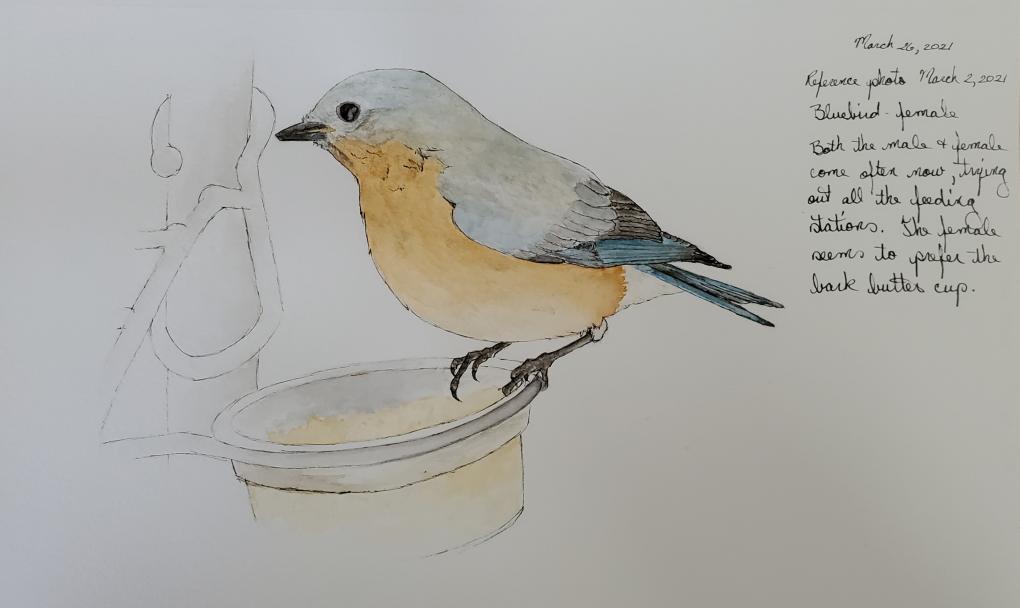The Cornell Lab Bird Academy › Discussion Groups › Nature Journaling and Field Sketching › Filling Your Sketches with Color
-
 Capturing stumps me. The wildlife do not hold a pose, the clouds interrupt the sun and shift shadows and tones, and as a beginner, I'm very slow in drawing. I'm discovering that I should take a photo to continue the rendering later, go back to observe at the same place multiple times if possible, and be patient with myself. If all I get is the temperature, wind, scents and sunlight, the day wins. I trust that I will improve in speed and skill the more I try, and meanwhile I'm enjoying God's good creation. Liz's instruction helps me appreciate it all the more.
Capturing stumps me. The wildlife do not hold a pose, the clouds interrupt the sun and shift shadows and tones, and as a beginner, I'm very slow in drawing. I'm discovering that I should take a photo to continue the rendering later, go back to observe at the same place multiple times if possible, and be patient with myself. If all I get is the temperature, wind, scents and sunlight, the day wins. I trust that I will improve in speed and skill the more I try, and meanwhile I'm enjoying God's good creation. Liz's instruction helps me appreciate it all the more. -
Hi Suzanne, I love how you have painted those tall dark green trees. I am going to try that style myself! Hope that's ok.
-
-
 1. I have a small zippered pouch to keep my drawing implements in at the field. Taking fewer items and making good notes to fill in later seems to work the best for me. 2. My goal was to improve at field sketching, drawing and watercolor painting. I make sure to always include at least a little background metadata on every page. I really want to try to capture the moments and memories spent outside. I really prefer to create from photos that I take though. Temperatures are in the 30's now and it is very difficult to draw for more than 10 minutes at a time. I also have a pandemic puppy that requires my full attention - so I am lucky to be able to snap a few photos while outside and then draw from the computer images later while she is napping!
1. I have a small zippered pouch to keep my drawing implements in at the field. Taking fewer items and making good notes to fill in later seems to work the best for me. 2. My goal was to improve at field sketching, drawing and watercolor painting. I make sure to always include at least a little background metadata on every page. I really want to try to capture the moments and memories spent outside. I really prefer to create from photos that I take though. Temperatures are in the 30's now and it is very difficult to draw for more than 10 minutes at a time. I also have a pandemic puppy that requires my full attention - so I am lucky to be able to snap a few photos while outside and then draw from the computer images later while she is napping! -
Using a 24 color Koi water color travel kit with water brush. Fantastic!
-

-
I made my first attempt at creating a watercolor from a reference photo combined with observations from my breakfast room window. I have observed a single Ruby-throated Hummingbird (Archilochus colubris) visiting my Turk's caps in the front yard. This small gem has visited my yard several times a day during the the last three weeks. I was not successful in obtaining my own photo, so I used a reference photo from someone else. I admire this little bird who visits daily and I know soon, he will be leaving for his migration. Perhaps I will get another chance to capture his brilliance. I have trouble with control using the water brush.

-
 My sit spot is in my back yard watching the birds that come to my feeders. Right now Ruby-throated hummingbirds are really tanking up preparing to migrate across the Gulf of Mexico. It is fascinating to watch them protect territory and fend off "invaders". Also, we were affected by Hurricane Nicholas so I wondered how much that had affected their migration. I really enjoyed the process of painting one of them at a feeder, but I have to admit, I wasn't too far out in the field so I had a table and everything I needed at hand. I try to be sure I include my observations and questions - even if its about my painting/drawing technique. I have really learned a lot about using water color, although I tend to default back to colored pencils.
My sit spot is in my back yard watching the birds that come to my feeders. Right now Ruby-throated hummingbirds are really tanking up preparing to migrate across the Gulf of Mexico. It is fascinating to watch them protect territory and fend off "invaders". Also, we were affected by Hurricane Nicholas so I wondered how much that had affected their migration. I really enjoyed the process of painting one of them at a feeder, but I have to admit, I wasn't too far out in the field so I had a table and everything I needed at hand. I try to be sure I include my observations and questions - even if its about my painting/drawing technique. I have really learned a lot about using water color, although I tend to default back to colored pencils. -
By trying to match the shade for the chrysalis, I realized the importance of using tint. I also muted the leaves with a bit of red because the original chartreuse popped out too much. In trying to add some mottling, I used too much water and that caused some hard edges. Most importantly, this exercise brought me right back to the beginning because what drove this for me was trying to document the fascinating process of the monarch butterfly. During the week I had been observing the caterpillars and thought they were dying. I was very dismayed. Yet, when I started researching I learned about their 5 molting phases. What a blessing to observe this so closely! I also worried that the metamorphic process was coming too late in the year. Now I know there are 4 generations of monarchs that complete the entire journey to Mexico. By seeing them this late in Virginia, this means that what I am observing is the 4th generation that will fly down to Mexico and start the 1st generation all over again!


-

 Practice painting as realistically as possible (for me) based on photo of Olive Backed Sunbird from eBird. This is a bird I often see around home, but they are very active. After spending a fair bit of time on the “realistic” version, just for fun I decided to do quick gesture sketches and add some of the left-over paint.
Practice painting as realistically as possible (for me) based on photo of Olive Backed Sunbird from eBird. This is a bird I often see around home, but they are very active. After spending a fair bit of time on the “realistic” version, just for fun I decided to do quick gesture sketches and add some of the left-over paint. -
Incredible! Hipeeeer-realistic!
-
-

-

-

-
How beautiful!
-
-
I love how the watercolor kits are so easy to carry but I once forgot to bring a paper towel for drying/wiping my brush. It made things a lot harder. So now I carry a little pencil box with scratch paper and paper towels to throw in with my personal kit. I find I have the hardest time waiting for the paint to dry and when I don't, sometimes the colors run together, like the yellow in this Seaside Sparrow's face. Also, eyes are hard to get right!

-

-
I painted from a photo this prairie warbler. I practiced using negative space, mixing colors, and attempting to keep my brush dry enough for some of the detail. I came out much better than my first attempt at a bird in watercolors! But I still need lots of practice.

-
I bring my binoculars along with my art materials. Spring is such an amazing time to see returning songbirds and the woods are full of warblers. Even if they don't sit still enough to draw or paint, I will try and commit them to memory for later. Bug repellent is a must have! I also bring water for myself in addition to refilling pens if need be. I try to note anything interesting, or things I want to look up when I get home. Lugging too many guide books can be a hassle. This was my best attempt at a landscape; a view off an escarpment atop Browns Hill.

-
Organizing material: Preparing my tools in a special bag helped so much. I had everything I needed and I was ready to go. While outdoors, I needed an extra empty bottle to discard used water. I will include it for next time. Responding to observation with drawing and water color is challenging and fun. It is exciting to mix colors to match with nature. I became more curious and tried to find answers to the questions I had during my observations. Below is my trial of capturing very nice trees. It is amazing how you see things differently when you draw and paint. Water color is a wonderful medium, because it is transparent and works well while painting outdoors. Negative space helped so much. I managed to correct proportions and draw more accurately.


-
The weather has been marginal to terrible this week. I haven't seen the mountain I

 want to use for my landscape in days...feels like Denali! As a result, I'm not getting out in the field much and end up painting a view from my window. I'm not real happy with my landscape, but I feel like I learned a lot doing it. I really have focused on my observational skills everywhere that I go, and think about how I would paint various scenes, how I might apply the techniques we've learned, what I need to work on and do differently. I do think I will take an extra paintbrush with me to use for dry on dry, the water brush is not working for me.
want to use for my landscape in days...feels like Denali! As a result, I'm not getting out in the field much and end up painting a view from my window. I'm not real happy with my landscape, but I feel like I learned a lot doing it. I really have focused on my observational skills everywhere that I go, and think about how I would paint various scenes, how I might apply the techniques we've learned, what I need to work on and do differently. I do think I will take an extra paintbrush with me to use for dry on dry, the water brush is not working for me. -
 1. I am not managing my materials well in the field, I am pretty much a kit explosion. My watercolours come in tubes so that doesn't help. Having said that, I am enjoying the process.
1. I am not managing my materials well in the field, I am pretty much a kit explosion. My watercolours come in tubes so that doesn't help. Having said that, I am enjoying the process. -
Have you tried squeezing some in small separate containers, like a gum holder? Or an egg carton?
-
-

-
Getting deep colors with lots of value was challenging, but repeated layering (and drying time between layers!) helped a lot. I also used a "stippling" technique with points of color on the tip of the brush very useful. Initial sketch and watercolor painting based on recent cover of Birds & Blooms.



-
I enjoyed your painting of the blue bird, Christopher. I will try the "stippling" technique that you mentioned. I will try this technique for fine detail areas. I have trouble with the water brush and have resorted to a fine tipped regular paint brush for small, detailed areas.
-
-
I painted this from a photo on the Birdwatchers of NH Facebook page. Still working on balancing values but progress. I attempted using white pencil for some feather features some show up but not all. I had fun with this and am happy with the eye details.
 The bird is a White Throated Sparrow.
The bird is a White Throated Sparrow. -
This has been a challenging attempt to draw and paint a female cardinal. I used mainly wet on dry technique in most of this picture with layering of color in the body. Used some dry brush on the branches and layering over them. I tried to create the shape by varying light wash on body .

-

-
What a beautiful painting! You have much talent.
-
-
 I picked a picture of a tufted titmouse from a magazine; this was different for me as I am used to using regular watercolor brushes and take my time and usually would take me at least a month to paint a detailed picture. I went outside my boundaries and did this in 3 days. so it is
not very good, but okay.
I picked a picture of a tufted titmouse from a magazine; this was different for me as I am used to using regular watercolor brushes and take my time and usually would take me at least a month to paint a detailed picture. I went outside my boundaries and did this in 3 days. so it is
not very good, but okay. -
Scott, this is exactly what I've come away with in this class - I usually take forever, but now I'm able to complete something in a reasonable amount of time! For me it's a combination of the techniques and Liz's constant refrain to not be hard on yourself!
-
-
I haven't done anything in the field yet. But here's my first line and wash from a reference photo that I took from my bird feeder. I struggle with not worrying about every detail and trying to make it look photo realistic. Although I enjoy working that way, for my field journal I want to keep things more simple and loose. One effect I want to achieve is keeping the focus/ detail/ colors on the main subject with the light wash and sketchy surroundings. I definitely have room for improvement, but for now I'm happy with my first try.

-
I love the way you have faded the lines towards the left as you go away from the main subject. Same thing at bottom of the feeder. Nicely done.
-
Read More:
 Capturing stumps me. The wildlife do not hold a pose, the clouds interrupt the sun and shift shadows and tones, and as a beginner, I'm very slow in drawing. I'm discovering that I should take a photo to continue the rendering later, go back to observe at the same place multiple times if possible, and be patient with myself. If all I get is the temperature, wind, scents and sunlight, the day wins. I trust that I will improve in speed and skill the more I try, and meanwhile I'm enjoying God's good creation. Liz's instruction helps me appreciate it all the more.
Capturing stumps me. The wildlife do not hold a pose, the clouds interrupt the sun and shift shadows and tones, and as a beginner, I'm very slow in drawing. I'm discovering that I should take a photo to continue the rendering later, go back to observe at the same place multiple times if possible, and be patient with myself. If all I get is the temperature, wind, scents and sunlight, the day wins. I trust that I will improve in speed and skill the more I try, and meanwhile I'm enjoying God's good creation. Liz's instruction helps me appreciate it all the more. 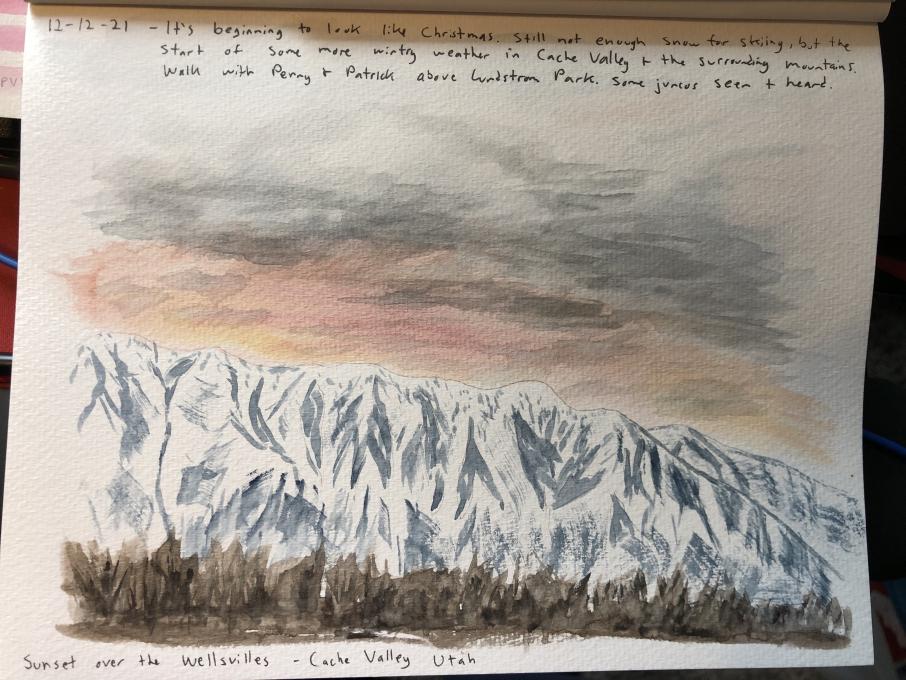 1. I have a small zippered pouch to keep my drawing implements in at the field. Taking fewer items and making good notes to fill in later seems to work the best for me. 2. My goal was to improve at field sketching, drawing and watercolor painting. I make sure to always include at least a little background metadata on every page. I really want to try to capture the moments and memories spent outside. I really prefer to create from photos that I take though. Temperatures are in the 30's now and it is very difficult to draw for more than 10 minutes at a time. I also have a pandemic puppy that requires my full attention - so I am lucky to be able to snap a few photos while outside and then draw from the computer images later while she is napping!
1. I have a small zippered pouch to keep my drawing implements in at the field. Taking fewer items and making good notes to fill in later seems to work the best for me. 2. My goal was to improve at field sketching, drawing and watercolor painting. I make sure to always include at least a little background metadata on every page. I really want to try to capture the moments and memories spent outside. I really prefer to create from photos that I take though. Temperatures are in the 30's now and it is very difficult to draw for more than 10 minutes at a time. I also have a pandemic puppy that requires my full attention - so I am lucky to be able to snap a few photos while outside and then draw from the computer images later while she is napping! 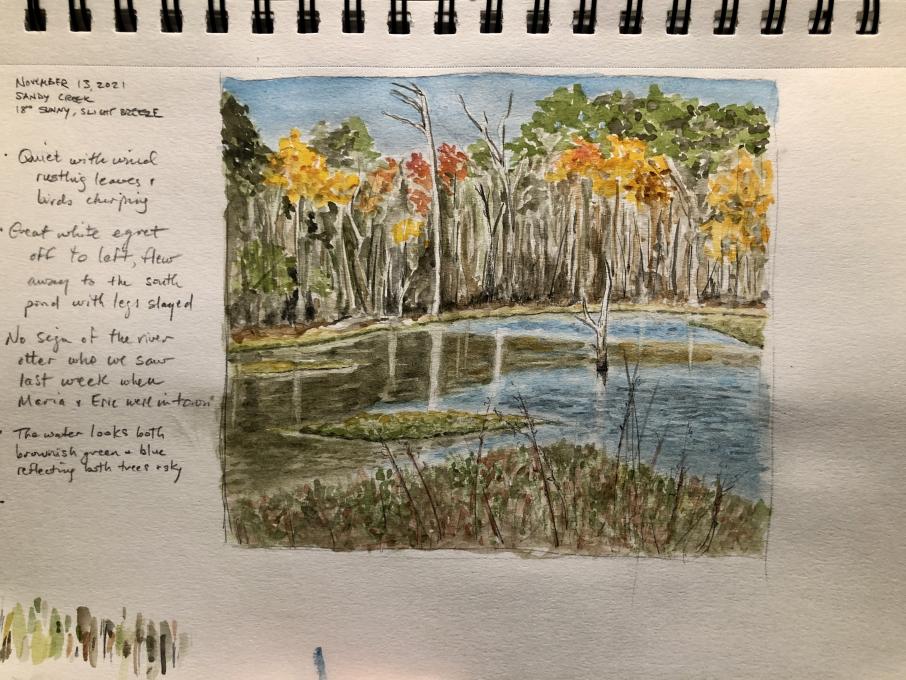
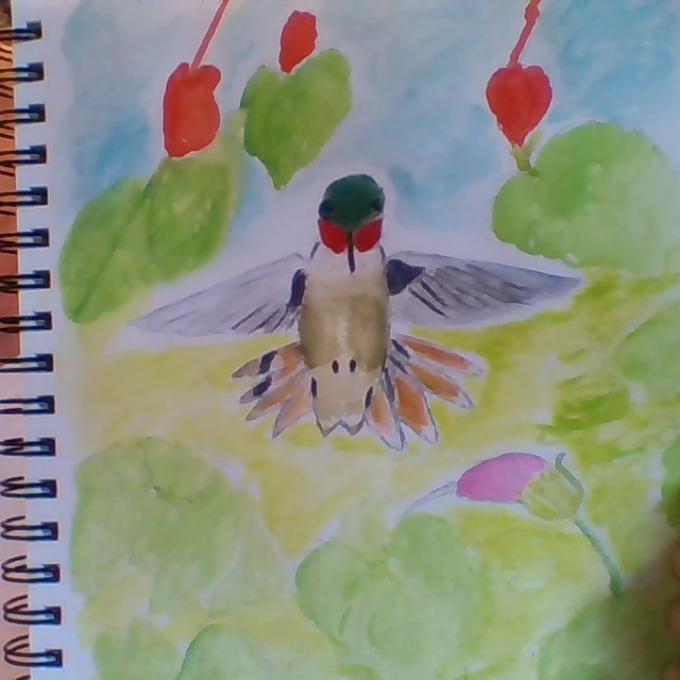
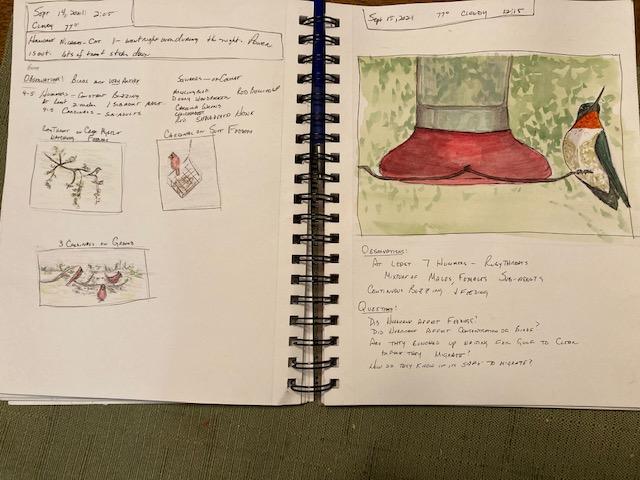 My sit spot is in my back yard watching the birds that come to my feeders. Right now Ruby-throated hummingbirds are really tanking up preparing to migrate across the Gulf of Mexico. It is fascinating to watch them protect territory and fend off "invaders". Also, we were affected by Hurricane Nicholas so I wondered how much that had affected their migration. I really enjoyed the process of painting one of them at a feeder, but I have to admit, I wasn't too far out in the field so I had a table and everything I needed at hand. I try to be sure I include my observations and questions - even if its about my painting/drawing technique. I have really learned a lot about using water color, although I tend to default back to colored pencils.
My sit spot is in my back yard watching the birds that come to my feeders. Right now Ruby-throated hummingbirds are really tanking up preparing to migrate across the Gulf of Mexico. It is fascinating to watch them protect territory and fend off "invaders". Also, we were affected by Hurricane Nicholas so I wondered how much that had affected their migration. I really enjoyed the process of painting one of them at a feeder, but I have to admit, I wasn't too far out in the field so I had a table and everything I needed at hand. I try to be sure I include my observations and questions - even if its about my painting/drawing technique. I have really learned a lot about using water color, although I tend to default back to colored pencils. 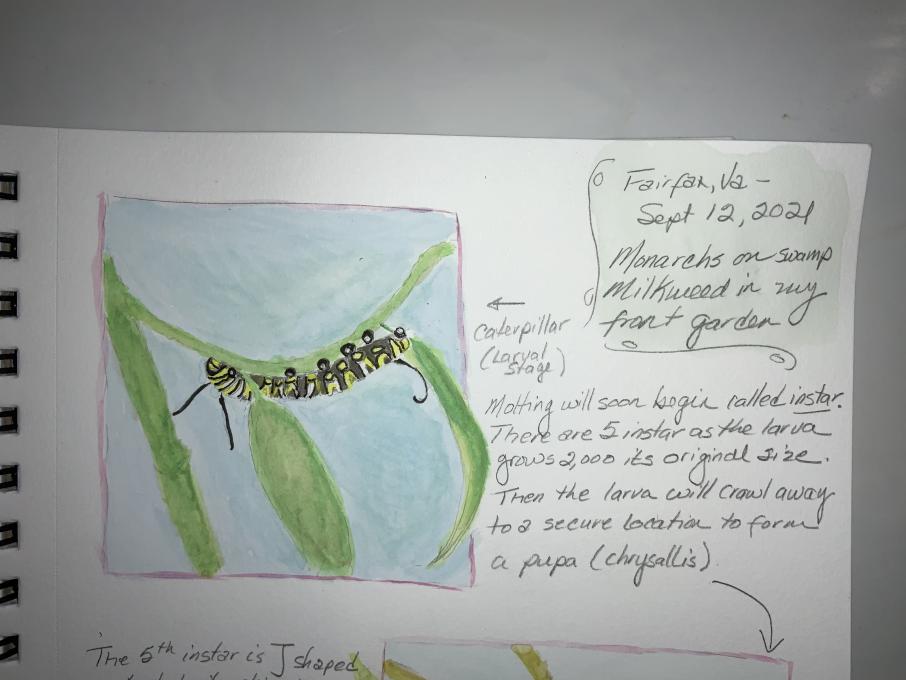
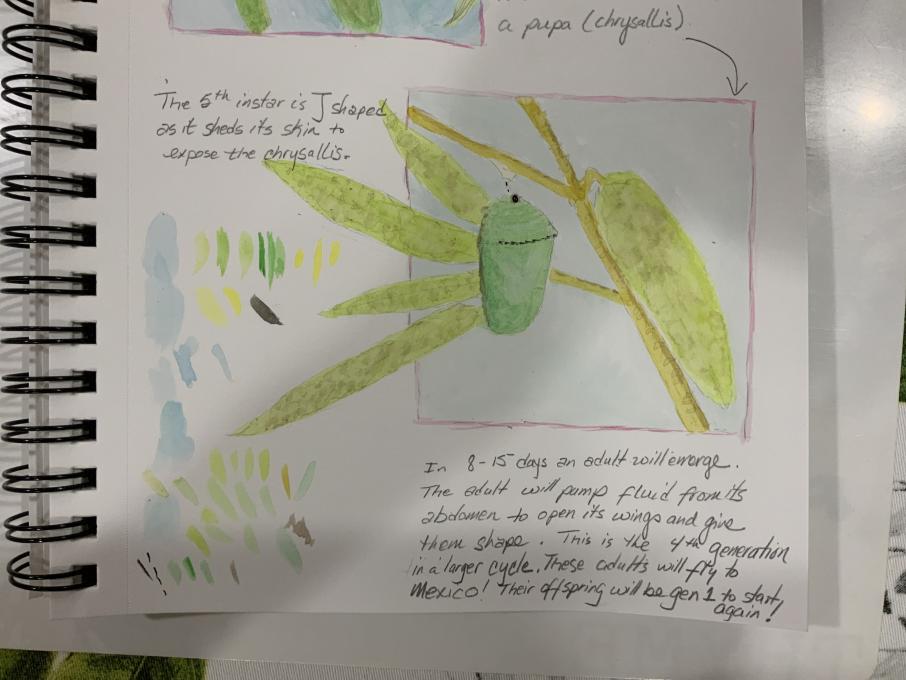
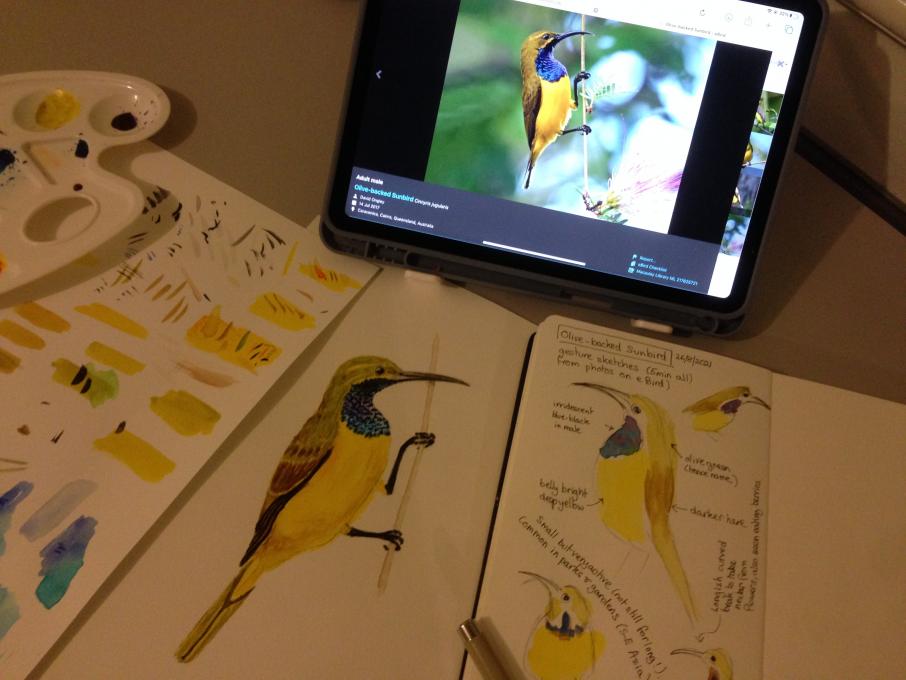
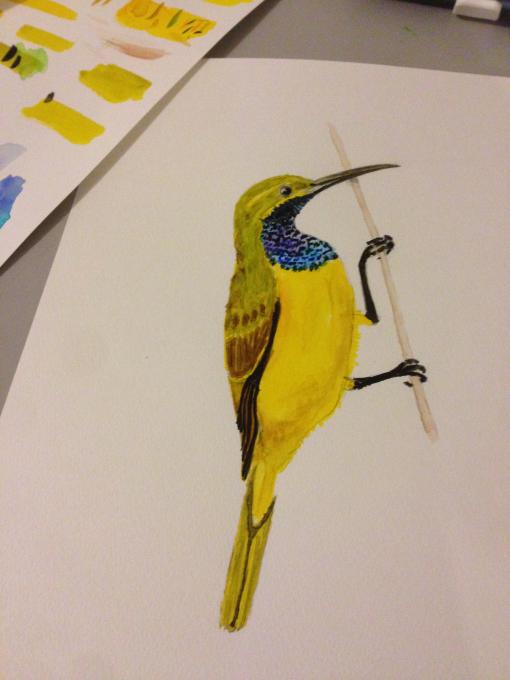 Practice painting as realistically as possible (for me) based on photo of Olive Backed Sunbird from eBird. This is a bird I often see around home, but they are very active. After spending a fair bit of time on the “realistic” version, just for fun I decided to do quick gesture sketches and add some of the left-over paint.
Practice painting as realistically as possible (for me) based on photo of Olive Backed Sunbird from eBird. This is a bird I often see around home, but they are very active. After spending a fair bit of time on the “realistic” version, just for fun I decided to do quick gesture sketches and add some of the left-over paint. 
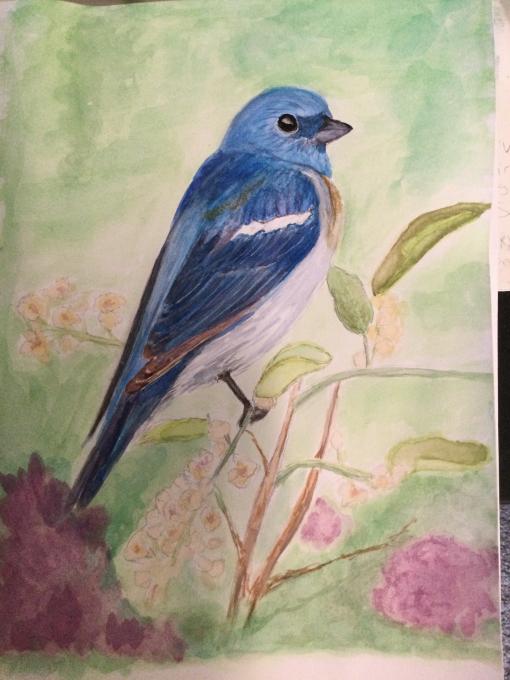
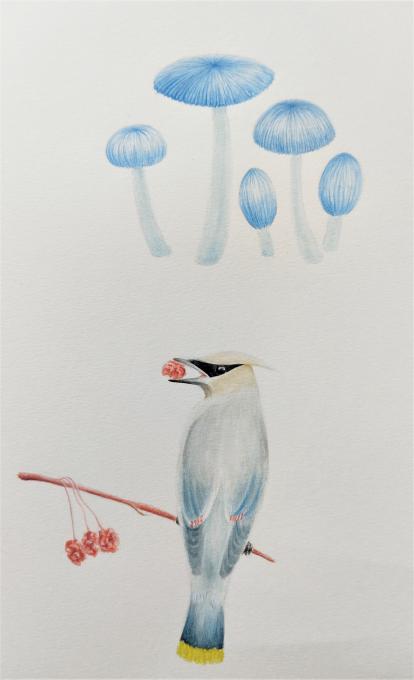
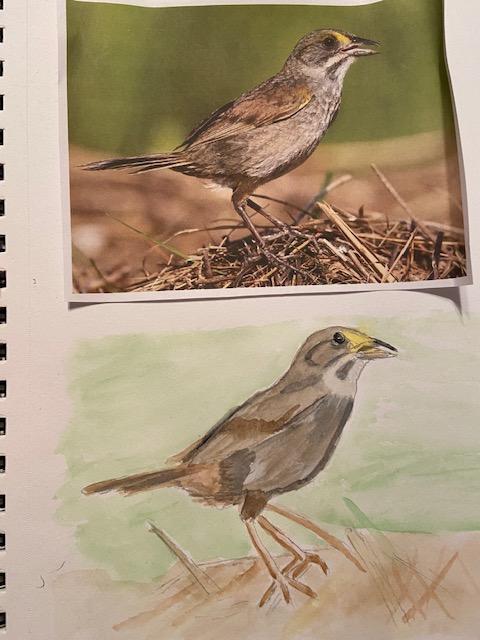
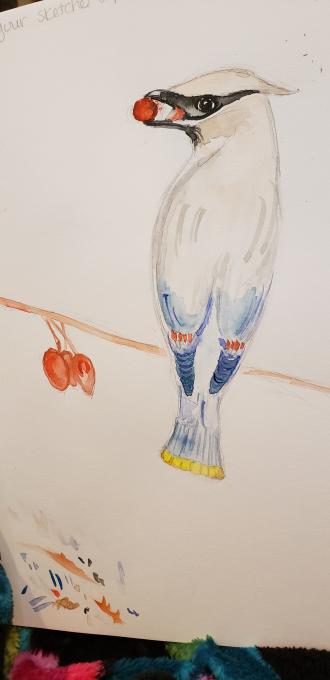
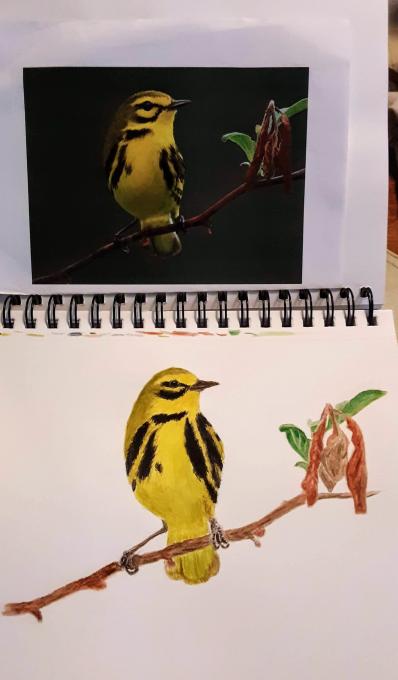
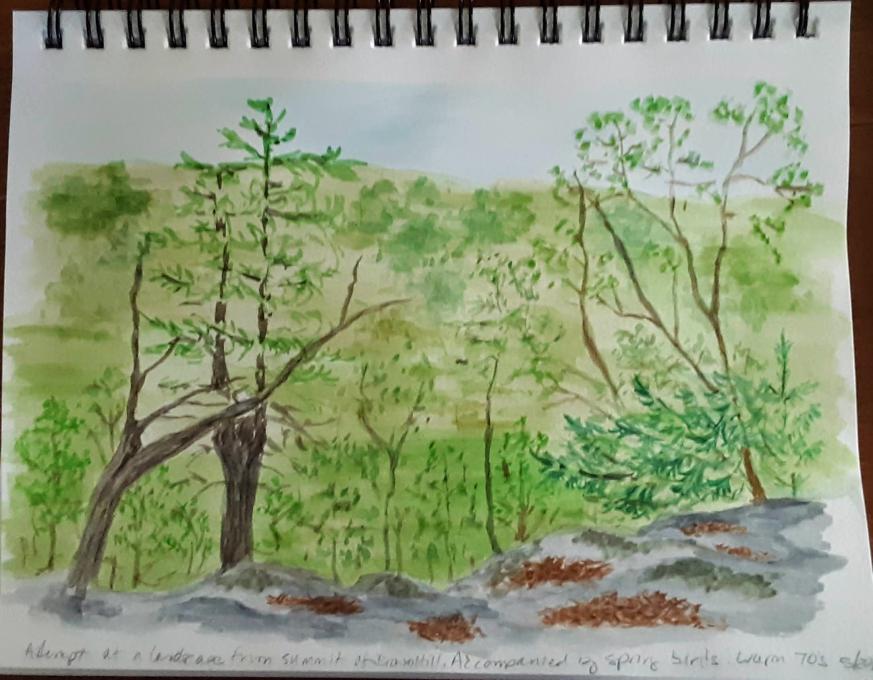
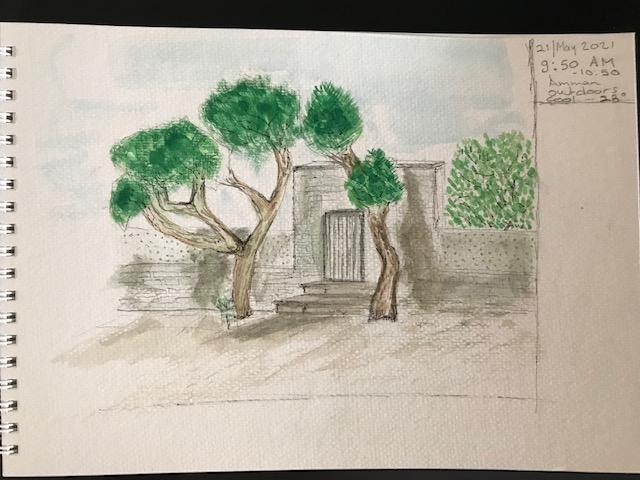
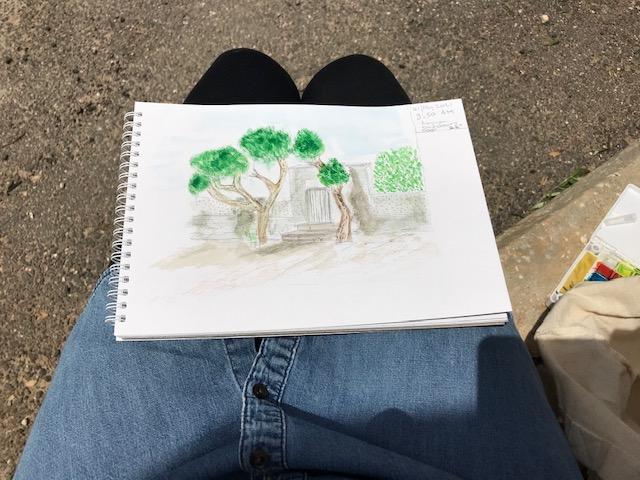
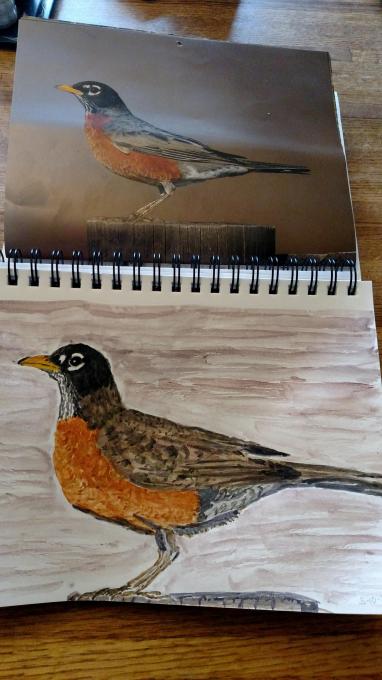
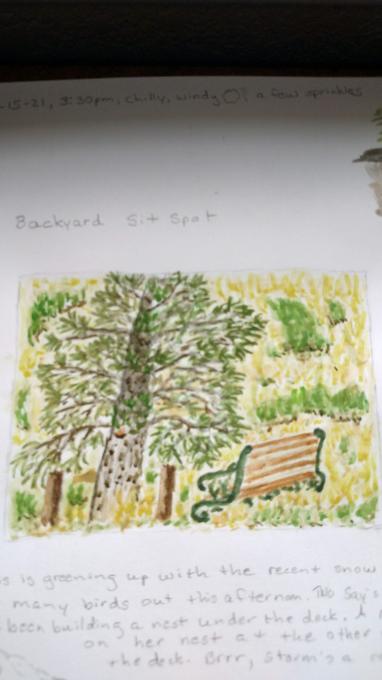 want to use for my landscape in days...feels like Denali! As a result, I'm not getting out in the field much and end up painting a view from my window. I'm not real happy with my landscape, but I feel like I learned a lot doing it. I really have focused on my observational skills everywhere that I go, and think about how I would paint various scenes, how I might apply the techniques we've learned, what I need to work on and do differently. I do think I will take an extra paintbrush with me to use for dry on dry, the water brush is not working for me.
want to use for my landscape in days...feels like Denali! As a result, I'm not getting out in the field much and end up painting a view from my window. I'm not real happy with my landscape, but I feel like I learned a lot doing it. I really have focused on my observational skills everywhere that I go, and think about how I would paint various scenes, how I might apply the techniques we've learned, what I need to work on and do differently. I do think I will take an extra paintbrush with me to use for dry on dry, the water brush is not working for me. 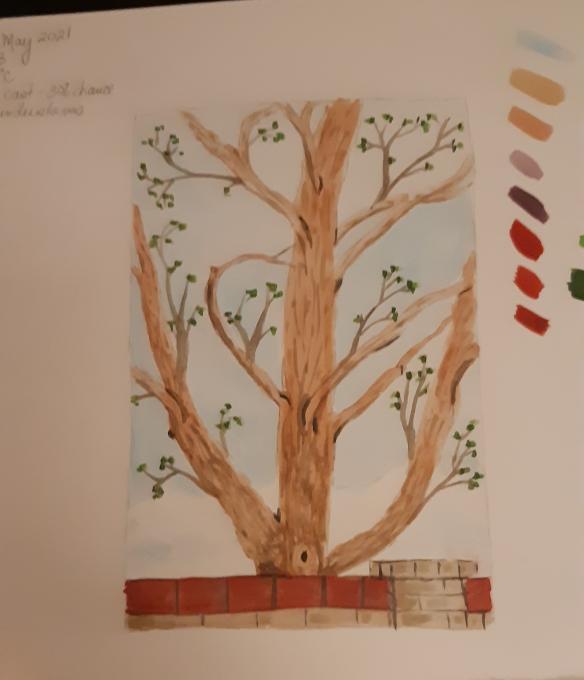 1. I am not managing my materials well in the field, I am pretty much a kit explosion. My watercolours come in tubes so that doesn't help. Having said that, I am enjoying the process.
1. I am not managing my materials well in the field, I am pretty much a kit explosion. My watercolours come in tubes so that doesn't help. Having said that, I am enjoying the process. 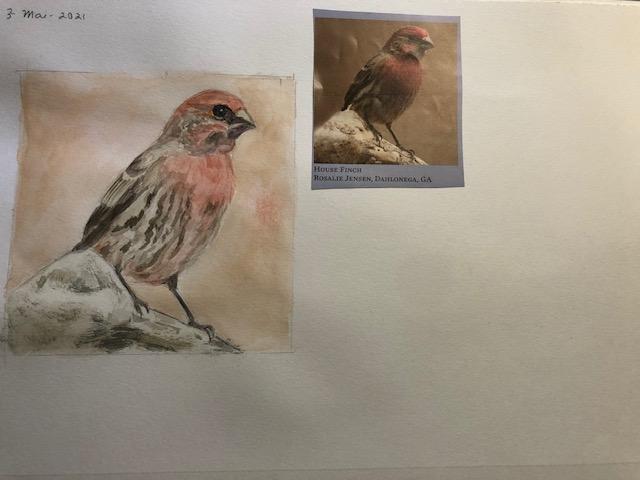
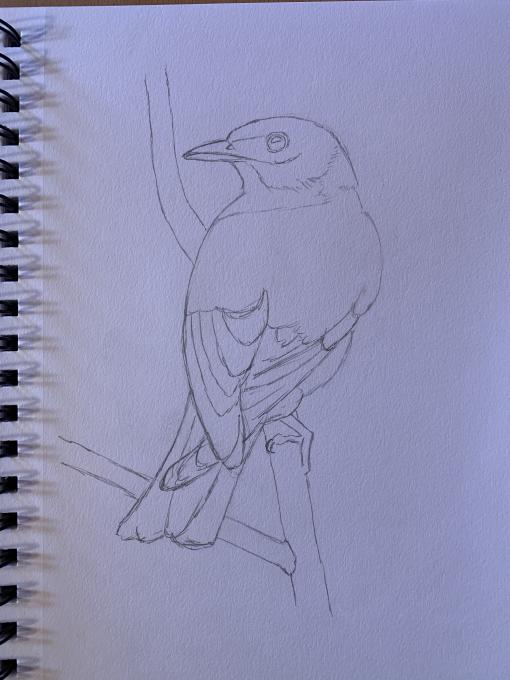
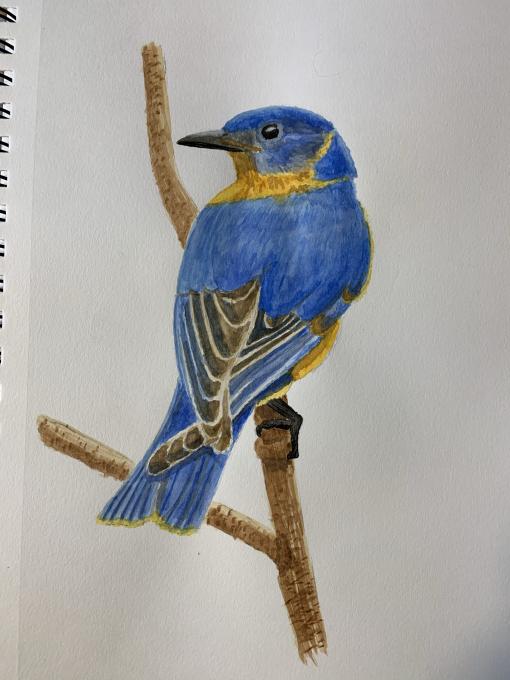
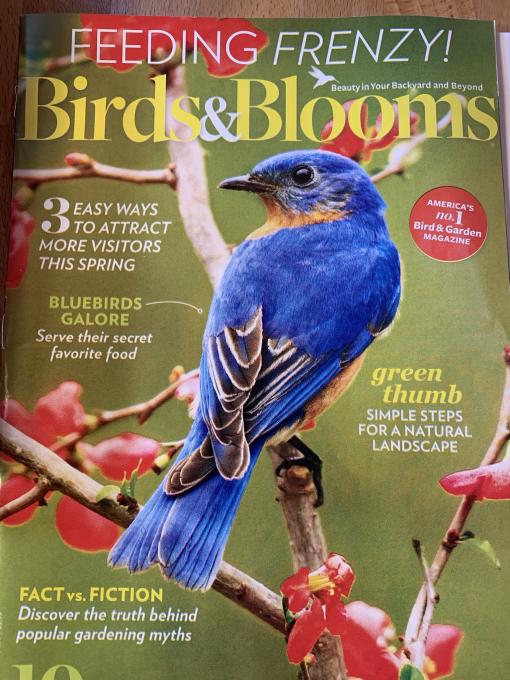
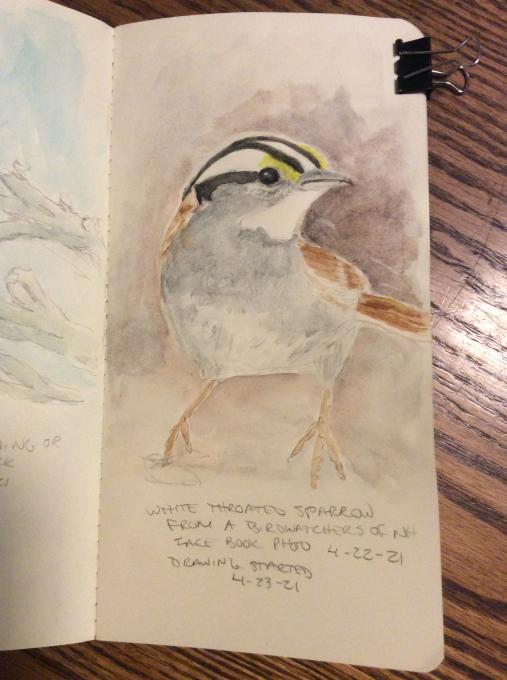 The bird is a White Throated Sparrow.
The bird is a White Throated Sparrow. 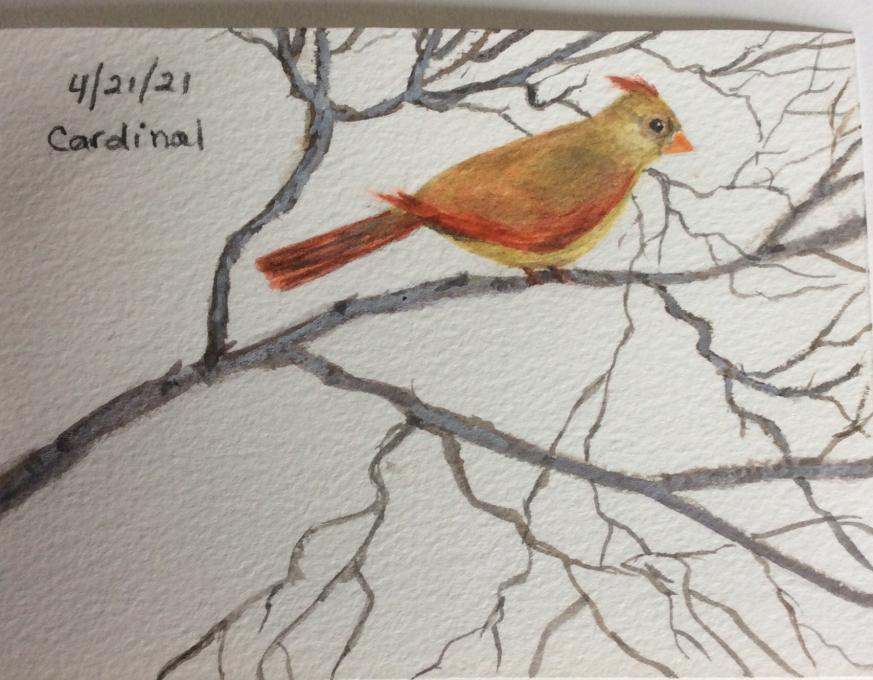
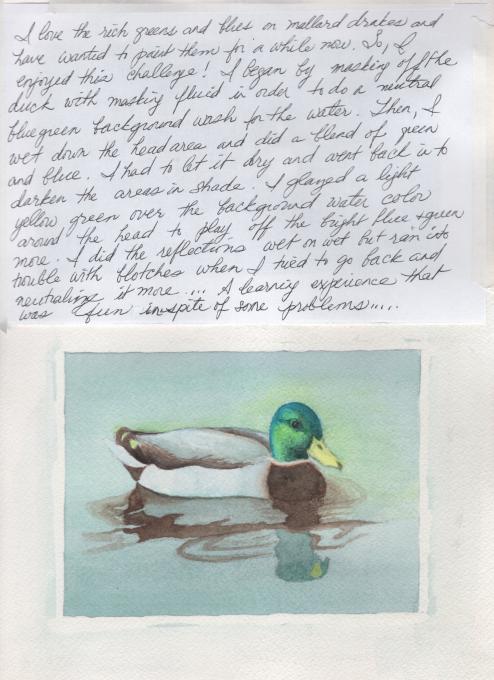
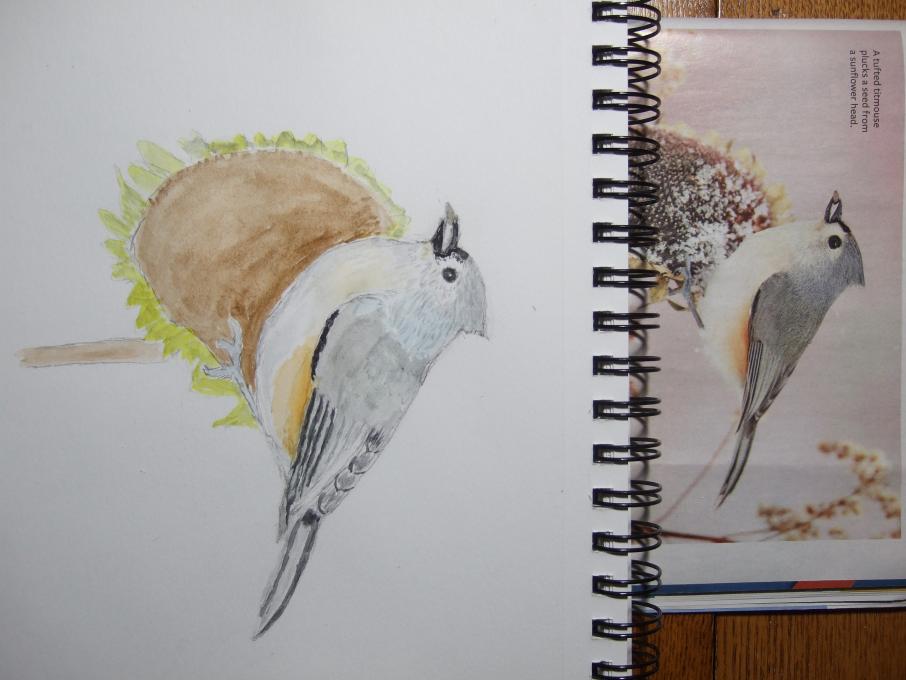 I picked a picture of a tufted titmouse from a magazine; this was different for me as I am used to using regular watercolor brushes and take my time and usually would take me at least a month to paint a detailed picture. I went outside my boundaries and did this in 3 days. so it is
not very good, but okay.
I picked a picture of a tufted titmouse from a magazine; this was different for me as I am used to using regular watercolor brushes and take my time and usually would take me at least a month to paint a detailed picture. I went outside my boundaries and did this in 3 days. so it is
not very good, but okay. 